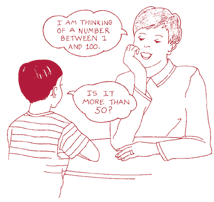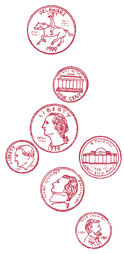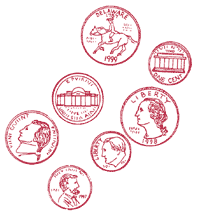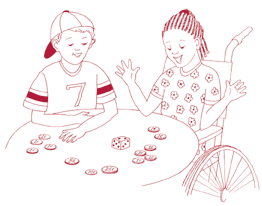|

Math for the Fun of It
During summer vacations, on rainy days, while waiting at the doctor's office, or on a stroll through the neighborhoodlearning never ends. Your children can explore some fascinating mathematical possibilities in the world around them every day. For instance, math can be found outdoors in nature: look for symmetry in leaves; count the number, sizes, and kinds of trees on your street; and look at the various shapes and patterns of blooming flowers. Children will be learning math and enjoying it too! The activities in this section can be done anytime and anywhere.
Guess If You Can (Grades K-5)
What to do:
- Let your child think of a number between a stated range of numbers while you try to guess the number by asking questions. Here is a sample conversation.
Child: I am thinking of a number between 1 and 100.
Parent: Is it more than 50?
Child: No.
Parent: Is it an even number?
Child: No.
Parent: Is it more than 20 but less than 40?
Child: Yes.
Parent: Can you reach it by starting at zero and counting by 3's?
Child: Yes.
(At this stage, your child could be thinking of 21, 27, 33, or 39.)
- Figure out the answers to your own questions.
- After you have guessed your child's number, let your child guess a number from you by asking similar questions.
Parent Pointer - It is important to help children develop an understanding of the characteristics and meanings of numbers. |
 What Are the Coins?
What Are the Coins? (Grades 2-5)
What you'll need:
Some coins
Ask your child the following questions:
- I have three coins in my pocket. They are worth 7 cents. What do I have? (a nickel and 2 pennies)
- I have three coins in my pocket. They are worth 16 cents. What do I have? (a dime, a nickel, a penny)
- I have three coins in my pocket. They are worth 11 cents. What do I have? (2 nickels and 1 penny)
- I have three coins in my pockets. They are worth 30 cents. What do I have? (3 dimes)
- I have six coins in my pocket. They are worth 30 cents. What could I have? (1 quarter and 5 pennies or 6 nickels). This problem has more than one answer. It is challenging for children to experience problems like this.
- I have coins in my pocket, which have a value of 11 cents. How many coins could I have?
You get the idea! Give your child a few coins to figure out the answers.
Parent Pointer - Use this activity to help your child develop an understanding of patterns and variables (the unknown) to solve a problem. This is critical to understanding algebra. |
 What Are My Chances?
What Are My Chances? (Grades K-4)
What you'll need:
Two coins, paper, and pencil to keep score
Play these games with your child:
- Flip one coin. Every time it comes up heads, your child gets 1 point. Every time it comes up tails, you get 1 point. Flip it 50 times. Tally by 5's to make it easier to keep track of scores. The person with the most points wins. If one person has 10 points more than the other person does, score an extra 10 points. Does this happen very often? Why not?
- Flip two coins. If the coins come up two tails or two heads, your child scores 1 point. If it comes up heads and tails, you get 1 point. After 50 flips, see who has more points. Do you think the game is fair? What if one person received 2 points for every double heads and the other person received 1 point for everything else. Is this fair?
- Flip one coin. Then flip the other. If the second coin matches the first coin, your child scores 1 point. If the second coin doesn't match the first coin, you receive 1 point. Try this 50 times. Is the result the same as in the previous game?
Parent Pointer - Understanding probability is essential in many areas of mathematics. Playing games that involve chance is one way to explore the laws of probability. |
 Money Match
Money Match (Grades K-2)
What you'll need:
One number cube to roll; 10 of each coin (penny, nickel, dime, and quarter)
- For young players (5 and 6 year olds) use only two different coins (pennies and nickels or nickels and dimes only). Older children can use all types of coins.
- Explain that the object of the game is to be the first player to earn a set amount (10 or 20 cents is a good amount).
- The first player rolls the number cube and gets the number of pennies shown on the cube. Keep all like coins in batches or stacks of 5 or 10.
- As each player accumulates 5 pennies or more, the 5 pennies are traded for a nickel. Players take turns rolling the cube to collect additional coins.
- The first player to reach the set amount wins.
- Add the quarter to the game when the children are ready. As each player accumulates 5 nickels, they are traded for quarters.
Parent Pointer - Counting money and batching in groups of 2's, 5's, or 10's teaches children matching skills and helps in the beginning stages of addition and multiplication. Children also learn how to identify coins and understand their values. |
Math Activities for Grades K-5:
|
|
|